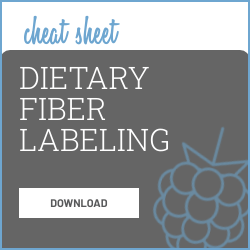Editor’s note: this post was originally published on June 27, 2016, and has been updated for accuracy and comprehensiveness.
The final rule for FDA’s 2016 updates to Nutrition Facts labeling incorporates two major changes to dietary fiber that food manufacturers need to be aware of: (1) a definition of “dietary fiber” – a term that FDA had not previously defined and (2) an increase in the DRV from 25 grams to 28 grams.
Dietary Fiber is a mandatory label nutrient, and for U.S. labeling, it is considered part of the carbohydrate total. Dietary Fiber includes both soluble and insoluble fiber, which can also be reported on the label. Before the FDA’s 2016 ruling, total dietary fiber was required on Nutrition Facts/Supplement Facts labels, regardless of whether the fiber had a proven benefit to health. The FDA sought to clarify this for consumers by establishing more rigorous definitions for dietary fiber.
Beneficial Fiber
The new definition focuses on reporting fiber that is considered beneficial to human health (i.e. exhibit physiological effects typically associated with the consumption of fiber, such as lowering blood pressure or cholesterol, or increasing satiety or bowel function). Dietary Fiber in the new regulations includes non-digestible carbohydrates and lignin that are found naturally in plants, plus added fiber (isolated or synthetic) that has a beneficial effect in humans. On Nutrition Facts/Supplement Facts labels, non-digestible carbohydrates that meet the definition of dietary fiber are listed as dietary fiber on the label and included as part of the total carbohydrate reported.
Below is the list of non-digestible soluble carbohydrates and isolated or synthetic fibers that are included in the new definition of Dietary Fiber:
- Acacia (Gum Arabic)
- Alginate
- Arabinoxylan
- Beta-glucan
- Cellulose
- Cross-linked phosphorylated starch (RS4)
- Galactooligosaccharide (GOS)
- Glucomannan
- Guar gum
- High amylose starch (resistant starch 2)
- Hydroxypropylmethylcellulose
- Inulin and inulin-type fructans
- Locust bean gum
- Mixed plant cell wall fibers
- Pectin
- Polydextrose
- Psyllium husk
- Resistant maltodextrin/dextrin
Note: This list has been updated to include all beneficial fibers approved by the FDA as of December 17, 2021. The originally published document had only 8 approved fibers listed.
Non-Digestible Carbohydrates
Other fibers (such as xanthan gum) can be added to a product, however, non-digestible insoluble carbohydrates that do not meet the definition of dietary fiber are not shown as dietary fiber on the label. They will still be included in the total carbohydrate number.
Food manufacturers that would like to determine total dietary fiber in their product according to the new definition must first determine the total amount of dietary fiber and then subtract the amount of non-digestible carbohydrates that do not meet the above definitions from this total.
Total amount of dietary fiber – non-beneficial, non-digestible carbs = Total dietary fiber per new definitions.
Below is a shortlist of non-digestible carbohydrates
Example: Oatmeal Fiber Bar
I want to create a high fiber oatmeal bar so I add 5g of cellulose (insoluble) and 5g of xanthan Gum (soluble) to my recipe. The oats account for 5g of fiber.
Previous Calculation:
Based on the previous Dietary Fiber definition both the xanthan gum and cellulose would count towards the dietary fiber total and my bar would have 15g of Total Dietary Fiber.
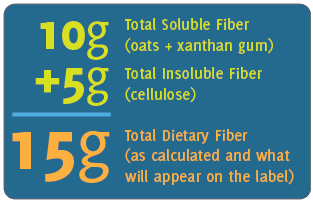
New calculation:
Based on the new Dietary Fiber definition my bar would have 10g of Total Dietary Fiber. The 5g of fiber from xanthan gum are not used to calculate Total Dietary Fiber, but they ARE calculated in the Total Carbohydrates.
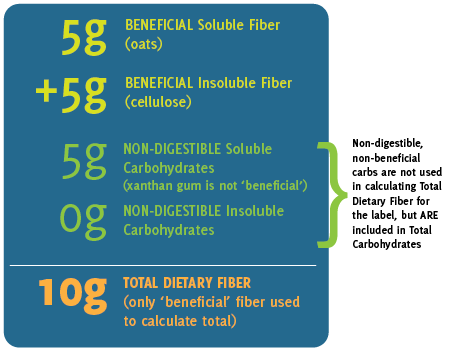
A New DRV for Dietary Fiber
In the 2016 ruling, the FDA increased the daily reference value (DRV) for dietary fiber from 25 grams per day to 28 grams per day. This increase will require all food manufacturers to update the percent daily value (%DV) for dietary fiber on all nutrition labels.
This may impact what fiber claims the food manufacturer is eligible to use on packaging.
Food manufacturers who wish to continue to make fiber claims on their product are encouraged to review the FDA’s final ruling to determine whether the non-digestible carbohydrates in their product meet the new definition. In some cases, products may require reformulation to continue to meet the requirements for the desired claims.
Nutrient Maintenance Records
The new labeling regulations require maintenance records to support the amounts of Dietary Fiber (as well as Added Sugars, Vitamin E, and Folate/Folic Acid) added to the label because there are no analytical methods that can distinguish the required nutrient definition. As a result, the FDA allows for use of electronic databases for analysis. The final rule requires that the records be kept for at least 2 years after the food is introduced to the market.
Nutrient Maintenance Records
- FDA Guidance for Industry: The Declaration of Certain Isolated or Synthetic Non-Digestible Carbohydrates as Dietary Fiber on Nutrition and Supplement Facts Labels
- Cheat Sheet: Dietary Fiber Labeling. Download this Cheat Sheet to use as your Dietary Fiber quick reference guide!
- Webinar: Taking a Closer Look at the FDA’s Definition of Dietary Fiber: This webinar examines the new Dietary Fiber definition in detail and discusses how to use the Genesis R&D Food program for compliance with the 2016 regulations.
- Webinar: Update on Dietary Fiber. This webinar provides an update on Dietary Fiber labeling and reviews the list of approved dietary fibers.
- Blog: Why Am I Not Seeing Dietary Fiber on my Label? This FAQ blog addresses why you might not see fiber on your Nutrition Facts label in Genesis R&D and explains how to fix it.
Other posts you might be interested in
View All Posts
Product Formulation
4 min read
| August 15, 2018
Nutrient Unit Conversion Calculations
Read More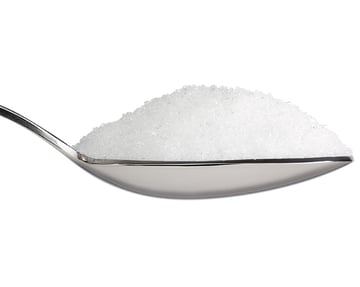
Product Formulation
3 min read
| June 20, 2016
FDA Nutrition Facts Label Nutrient Changes Part 1
Read More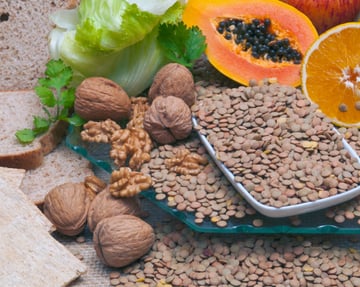
Product Formulation
5 min read
| August 12, 2016


